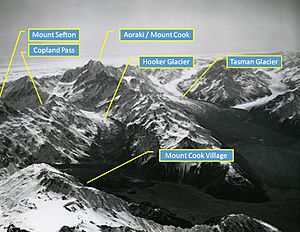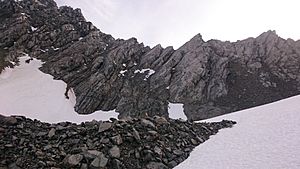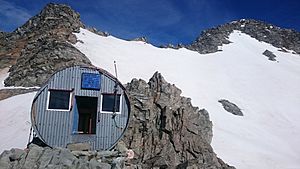Copland Pass facts for kids

The Copland Pass is a mountain path high up in the Southern Alps of New Zealand. It's about 2,150 meters (or 7,054 feet) above sea level. The local Māori know it as Noti Hinetamatea. This name honors Hinetamatea and her sons, who were important ancestors.
This pass is part of a traditional hiking trail. It connects Mount Cook Village with the West Coast of New Zealand. The pass is about 26 kilometers (16 miles) south of Fox Glacier. It sits on the main mountain range, right on the edge of two national parks: Aoraki / Mount Cook and Westland Tai Poutini National Park.
Contents
Naming the Pass
The Copland Pass is named after the Copland River. This river flows on the western side of the main mountain range. A surveyor named J. G. Roberts might have named the river after Dr. James Copland. He was one of the first settlers in Otago.
First Crossings
In February 1895, two climbers, Edward FitzGerald and Matthias Zurbriggen, crossed the mountains. They went over a pass about 500 meters (1,640 feet) south of Copland Pass. This lower pass, at 2,109 meters (6,919 feet), is now called FitzGerald Pass.
A month later, Arthur Paul Harper became the first non-Māori man to cross the Copland Pass. He named it after the Copland River. In 1903, Jane Thomson was the first non-Māori woman to successfully cross the pass.
Is it Safe to Cross?
Since the mid-1990s, the path leading up to the pass from the eastern side has become very difficult. This is because of serious erosion, which means the ground is wearing away. The pass is now extremely challenging to climb.
The Department of Conservation gives important advice. They say only people with a "high level of mountaineering experience" should try to cross. You also need the right climbing gear. Sadly, many accidents have happened here over the years. It is also advised to only cross the pass from east to west.
Old Mountain Hut
There used to be a hut called Hooker Hut on the eastern side. It was a common stop for people crossing the pass. However, the hut is no longer safe to reach. It is now stuck on a moving pile of rock and dirt called a moraine, which is eroding.
Climate at Copland Pass
The weather at Copland Pass is very cold because it's so high up. It's known as a tundra climate. This means it's usually cold, even in summer.
Temperatures
In February, which is summer in New Zealand, the average high temperature is about 13.5°C (56.3°F). But in July, during winter, the average low temperature drops to about -11.8°C (10.8°F). In winter, temperatures often stay below freezing all day. Even in summer, the nights can be just below 0°C (32°F).
The temperature can change a lot between day and night. This is because the high altitude means heat escapes quickly after the sun goes down. The average yearly temperature at Copland Shelter, which is near the pass, is only 0.3°C (32.5°F).
| Climate data for Copland Shelter, 1960 m | |||||||||||||
|---|---|---|---|---|---|---|---|---|---|---|---|---|---|
| Month | Jan | Feb | Mar | Apr | May | Jun | Jul | Aug | Sep | Oct | Nov | Dec | Year |
| Mean daily maximum °C (°F) | 13 (55) |
13.5 (56.3) |
10.8 (51.4) |
7.4 (45.3) |
3.8 (38.8) |
0.5 (32.9) |
−0.3 (31.5) |
0.1 (32.2) |
4.6 (40.3) |
6.9 (44.4) |
9.1 (48.4) |
11 (52) |
6.7 (44.1) |
| Daily mean °C (°F) | 5.8 (42.4) |
6 (43) |
3.8 (38.8) |
0.8 (33.4) |
−2.3 (27.9) |
−5.3 (22.5) |
−6 (21) |
−4.6 (23.7) |
−1.9 (28.6) |
0.3 (32.5) |
2.3 (36.1) |
4.3 (39.7) |
0.3 (32.5) |
| Mean daily minimum °C (°F) | −1.2 (29.8) |
−1.3 (29.7) |
−3.3 (26.1) |
−5.7 (21.7) |
−8.5 (16.7) |
−11.1 (12.0) |
−11.8 (10.8) |
−10.7 (12.7) |
−8.4 (16.9) |
−6.3 (20.7) |
−4.5 (23.9) |
−2.5 (27.5) |
−6.3 (20.7) |
| Average rainfall mm (inches) | 360 (14.2) |
230 (9.1) |
390 (15.4) |
300 (11.8) |
323 (12.7) |
252 (9.9) |
250 (9.8) |
270 (10.6) |
320 (12.6) |
370 (14.6) |
340 (13.4) |
365 (14.4) |
3,770 (148.4) |
| Source: Climate-data.org, combined averages from Fox Glacier & Mt Cook Village | |||||||||||||



